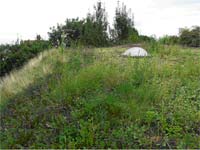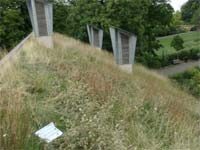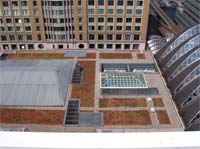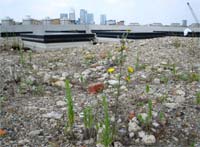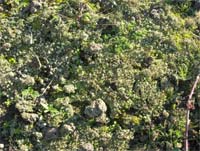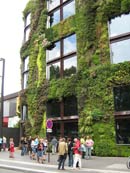Extensive Green Roofs in London
by Gary Grant
EcoSchemes Ltd, Unit 1, Coombe Lane, Axminster, EX13 5AS, U.K.
Abstract
This paper gives an overview of extensive green roofs in London and considers their potential to benefit the conservation of biodiversity. Categories of green roofs described include grass roofs of the early 1990s; mass-produced Sedum roofs, first installed in the late 1990s; and recently installed roofs made from crushed concrete and brick designed to provide habitat for the rare black redstart (Phoenicurus ochruros). The role that green roofs potentially play in conserving rare invertebrates associated with derelict sites is discussed, as are possible future directions for biodiverse green roofs. Green roofs are acknowledged as a premier example of multifunctional urban design.
Key words: Green roofs; living roofs; urban nature conservation; urban biodiversity; building-integrated vegetation; black redstart; green facades; multifunctional urban design
Introduction
The purpose of this paper is to summarize the various categories of extensive green roof (Forschungsgesellschaft Landschaftsentwicklung Landschaftsbau, 1995; 2002) that have been constructed in London during the past 15 years, describe their ecology (as far as it is known), and provide some insight into the objectives of the designers. I also review a number of recent ecological surveys of green roofs that have been conducted in London. In addition, I discuss how the green roof concept may continue to develop in the future.
First, some background: London is the capital of the United Kingdom and has a population of 7.5 million. It was founded by the Romans about 2,000 years ago on the Thames, a tidal river, which once flowed through salt marshes, alder swamps, and oak forests. Since that time, London has grown to include the original urban center, inner-city areas that flourished during the 19th century, and sprawling suburbs that continued to grow into the 20th century. The Greater London area now covers 1,579 square kilometers. (For further general information about the city of London, see www.london.gov.uk). London has a temperate climate, with warm summers and mild winters. The highest recorded summer temperature was 38.1°C (100.58°F) at the Royal Botanic Gardens, Kew, in 2003. Moderate rainfall occurs year-round (average annual precipitation is 700 millimeters). Because it is unusual for temperatures to fall below freezing, snow is uncommon and rarely settles. (For more information on London's climate, see www.metoffice.gov.uk.) London has many parks and green spaces, including some with extensive tracts of seminatural habitat; however, the distribution of these areas is uneven, with deficiencies often seen in the poorest inner-city communities. Many buildings destroyed by bombing raids during World War II were not immediately rebuilt, and these vacant sites were colonized by wildlife. As London's industry and docks declined, other sites were cleared and subsequently colonized by diverse vegetation. However, from the 1980s to the present day, with government policy encouraging the reuse of abandoned sites, these sanctuaries for nature have been increasingly redeveloped. Although new parks have occasionally been created within the redeveloped sites, these are nearly always ecologically impoverished, lacking the diversity and cover provided by the original vacant sites. This squeeze on urban biodiversity has led urban nature conservationists to look more closely at buildings as potential locations for habitat to compensate for that lost through urban-renewal schemes. The potential for roof greening is considerable: Roofs cover 24,000 hectares, or 16% of Greater London (Greater London Authority, 2001).
Grass Roofs
In the late 1980s and early 1990s, various charities, institutions, housing cooperatives, and individuals in and around London commissioned the architecture firm Architype and others associated with the Walter Segal Trust (see www.segalselfbuild.co.uk) to design a number of new buildings. The architects had adopted the philosophy of "footprint replacement," whereby green space lost through development is reestablished on the roof (an approach very eloquently expounded by Malcolm Wells, the American advocate of earth-sheltered building—see www.malcolmwells.com). I was one of the client's representatives for one of these buildings (the Center for Wildlife Gardening, built for the London Wildlife Trust) and was subsequently asked to advise on the specification for the green roofs on this and a number of other buildings, including the Center for Understanding the Environment (CUE) Building at the Horniman Museum Extension and 11 Shaw's Cottages (Figure 1), both in south London.
The latter was constructed in 1993 as a private residence for the architect Jon Broome, formerly of Architype. The building consisted of one main curved roof and four subsidiary flat roofs covering a total of 200 square meters. The roof membrane for each section was made of butyl rubber and protected by a nonwoven polypropylene geotextile fleece supported by a plywood deck. In order to promote biological diversity, a variety of substrates were used, including a chalk and subsoil mixture, loamy topsoil, and gravel. Substrate depth varied between 50 millimeters for the gravel and up to 100 millimeters for other areas. On the steepest sections, lawn turf, which had been rescued from the building footprint, was placed upside down (to promote plant colonization) on a framework of wooden battens. The various areas were seeded at the recommended rates with commercially available native wildflower seed mixes designed for alkaline, neutral, and acid soils (Emorsgate EM6, EM5, and EM7, respectively; see www.wildseed.co.uk for species lists). In addition, a mix of annual cornfield weeds (Emorsgate EC1) was used to provide a show of color in the first growing season. The gravel was seeded with Sedum acre. The owner added more S. acre and S. reflexum later. Coir matting with a 25-millimeter mesh size was used to prevent soil erosion on the sloped roof sections. No management is undertaken apart from removal of Buddleja davidii and tree seedlings.
In 2001, botanist Barry Nicholson and I returned to describe the vegetation in the two larger sections of the roof (Grant, Engleback & Nicholson, 2003). It was remarkable how much the areas had converged, despite their differing soil chemistry and aspect. Vegetation cover on both substrates was completely closed. Bryophytes and sedums were prominent in both, and a very similar range of other species was present, including several ruderals. The main difference between the two sections was the domination of Geranium molle in the chalk-rubble area. The turfed areas supported a dense tussocky grassland sward that consisted of the grasses Agrostis stolonifera, Dactylis glomerata, and Phleum bertolonii, and included the herb Cerastium fontanum, Trifolium repens, Plantago lanceolata, Rumex obtusifolius, Malva sylvestris, Medicago lupulina, and Euphorbia peplus. A shady drip zone on a flat part of the roof below an overhanging section of turfed pitched roof had developed a spontaneous cover of Geranium robertianum and Plantago lanceolata.
Jones (2002) sampled invertebrates at 11 Shaw's Cottages as part of a study of eight extensive green roofs in London. Although none of the species were endangered, a total of 54 species were found, the most for any of the roofs studied. Species singled out for special mention were Metabletus foveatus, a ground beetle of dry sandy places, Scolopostethus decoratus, a ground bug of open sandy heaths, and Pseudeuophrys erratica, a spider found under stones and on walls normally in the north of England and Scotland. Jones noted that invertebrate species diversity is related to roof age, substrate depth, and substrate structure—a pattern that had previously been established by Brenneisen (2001) in a detailed study of green roofs in Basel, Switzerland.
The CUE Building at the Horniman Museum, in Forest Hill, south London, with a 250-square-meter pitched roof, was also designed by Architype and opened in 1994. In specifying the green roof, I worked closely with Peter Costa, a building-services engineer who wanted to cool the structure in summer through increased evapo-transpiration by irrigating the roof. Five years after construction, the roof's reservoir pond was filled and its automatic irrigation system abandoned (having been clogged with algae), although some occasional watering continues. One section of the roof is south facing and has an 8-degree pitch; the other is north facing and has a 27-degree pitch (Figure 2). The roof is mowed annually, usually in late summer.
The green roof was established using 100 millimeters of low-fertility subsoil mixed with alginate (to improve water retention) on a wooden batten grid. A commercially available Festuca-Agrostis turf was then laid on the soil layer, and wildflower plugs were inserted. Campanula rotundifolia, Galium verum, Prunella vulgaris, Scabiosa columbaria, Leucanthemum vulgare, Lotus corniculatus, Viola tricolor, and Vicia cracca plugs were specified, although the current presence of other species uncharacteristic for the locality suggests that a different combination was actually used.
Nicholson (2004) surveyed the vegetation ten years after establishment and found that the roof had developed into a species-rich neutral grassland supporting a number of plants notable to London. The south-facing section was sandy and dry. The dominant grasses found in this area were Festuca rubra, Agrostis capillaris, and A. stolonifera, while Dactylis glomerata and Poa pratensis occasionally occurred. Meadow wildflowers included Anthyllis vulneraria, Salvia verbenaca, Leucanthemum vulgare, Trifolium repens, Lathyrus pratensis, and Lotus corniculatus. Gaps in the turf supported annuals including Aira caryophyllea, Vulpia myuros, Cerastium glomeratum, Arenaria serpyllifolia, Geranium rotundifolium, and Viola arvensis. Mosses were also frequent in the more open areas, including Bryum capillare, Ceratodon purpureus, Hypnum cupressiforme, Pseudoscleropodium purum, and Brachythecium rutabulum. The north-facing section was wetter and also dominated by Festuca rubra and Agrostis species, but it also contained taller meadow grasses such as Arrhenatherum elatius and Phleum bertolonii. There was a luxuriant growth of mosses made up of Rhytidiadelphus sqaurrosus, Brachythecium rutabulum, B. albicans, Kindbergia praelonga, and Calliergonella cuspidata. Meadow wildflowers were more abundant on the north-facing section, and annual species, although present, were less prevalent than on the south-facing section.
Sedum Roofs
Canary Wharf is a major high-rise office complex (Figure 3) being built in a former dock area in east London (construction was started during the 1980s and has yet to be fully completed). In 1987, I was at a meeting with the developer, Olympia & York, when that company expressed an interest in using green roofs to improve the appearance of buildings overlooked by the main office tower. However, it wasn't until 1999, long after the development had passed into new ownership, that the first of several buildings in the area (now totalling over 5,000 square meters) was fitted with commercially available pregrown Sedum matting supplied by major green roof manufacturers (for example, companies such as Bauder, Alumasc, and Sarnafil). Some of the material was imported from continental Europe, and the rest was grown in the U.K. Between 2000 and 2004, other Sedum roofs were installed at scattered locations across London, covering a total area of more than 10,000 square meters. A further 11,000 square meters of Sedum roofs were installed in 2005 by Bauder alone, and more roofs are planned (data from www.livingroofs.org, and Bauder). Sedum roofs are the predominant type of extensive green roof in London. A typical Sedum mat is 20 millimeters thick and is delivered as a roll and laid onto 50 to 70 millimeters of growing medium—typically crushed brick or light, expanded clay aggregate. Sometimes Sedum mats are laid onto another water-retention layer. Another method is to hydroseed or plug plant Sedum into a 70-millimeter-thick layer of growing medium. Sedum is popular with green roof manufacturers because of its drought and frost resistance. Species used in the matting at Canary Wharf include Sedum album, S.acre, S.reflexum, S.spurium, S.pulchellum, S.sexangulare, S.hispanicum, S.kamtshaticum, and Saxifraga granulata (Jones, 2002). It forms a closed sward but is also colonized by mosses (such as Tortula muralis and Ceratodon purpurea) and ruderal species such as Stellaria media. Sedum mats are not irrigated (except sometimes during establishment), but weeds and tree seedlings are normally removed as part of routine maintenance.
Jones (2002) surveyed the invertebrates of three of the Canary Wharf Sedum roofs and found a total of 48 species. Notable species included Helophorus nubilis, a scarce "crawling water beetle," Chlamydatus evanescens, a nationally rare leaf bug, Erigone aletris, a North American spider recently naturalized in the U.K., and Pardosa agrestis, a nationally scarce wolf spider. It is suspected that Chlamydatus evanescens, perhaps along with other invertebrates, was imported into the U.K. with pregrown Sedum mats from central or eastern Europe.
Black Redstart Roofs
The black redstart, Phoenicurus ochruros, spread northward from continental Europe in the 19th century and started breeding in Britain in the 1920s. It colonized London's bomb sites after World War II and its derelict industrial sites from the 1960s onward. The species is rare in the U.K.: There are between 50 and 100 breeding pairs, and the bird's nests, eggs, and fledglings are fully protected under U.K. law (although its habitat is not). A Species Action Plan has been devised for the black redstart under the U.K. Biodiversity Action Plan (BAP) system (see jncc.defra.gov.uk/page-5155 and www.blackredstarts.org.uk). In 1997, proposed redevelopment of derelict sites in Deptford, southeast London, which included some of the breeding localities of this bird, alerted local conservationists to the need to provide replacement habitat (Frith & Gedge, 2000). Green roofs were identified as the potential solution to this problem and were designed to mimic the conditions found on the derelict sites favored by the black redstart. Initially termed "brown roofs," these roofs were constructed from recycled crushed concrete and brick aggregate and were allowed to be colonized naturally (Gedge, 2003; Figure 4).
The first such roof (constructed in 2002) was on the Laban Centre; another was built at the nearby Creekside Centre. An estimated 15,000 square meters of roof designed to benefit black redstarts are already planned (Gedge, 2003), most of them mandated by local authorities (following advocacy by external activists) as part of the building-permit process. Further plans for roofs of this type are expected because the regeneration of London's postindustrial areas is far from complete. Based on present trends, Gedge (personal communication, 2005) estimates that a further 400,000 to 500,000 square meters of biodiverse green roofs will be constructed in London as these areas are redeveloped.
Natural colonization by plants on the roofs in Deptford has been disappointingly slow. In hopes of speeding up plant growth, a locally appropriate wildflower seed mix has been applied, adapted from a seed mix I have developed for similar habitats on the main campus of the London 2012 Olympics. This strategy follows the example of similar aggregate-covered roofs in Basel, Switzerland (Brenneisen, 2001).
As well as the black redstart, there is concern for other species—most notably rare invertebrates—associated with derelict sites in London (Harvey, 2001). The London Wildlife Trust has estimated that of the 1,400 wildlife sites identified by the Greater London Authority, about 25% are previously developed sites likely to be redeveloped (Chipchase et al., 2002). Brown or biodiverse roofs have also been suggested as part of the solution to this problem (Wells, 2001), but recent surveys of the invertebrates of green roofs (Jones, 2002; Kadas, 2003) suggest that they do not support the species of conservation concern on derelict sites. This should not come as a surprise, however, since the green roofs already in existence were not designed to re-create the habitats found on derelict sites. In a new Ph.D. research project, Gyongyver Kadas, of the Royal Holloway College of the University of London, is experimenting with various treatments in test plots on roofs at Canary Wharf and London Zoo (see http://www.livingroofs.org/livingpages/casekomodo.html) to see how to maximize habitat for wildlife (including invertebrates of conservation concern). In Switzerland, increases in invertebrate diversity on green roofs have resulted from creating areas that retain moisture, varying substrate content and depth, and leaving dead stems and wood (Brenneissen, 2001). It is hoped that by comparing new local research with results from overseas, there will be a continuous improvement in London green roofs designed to mitigate habitat loss.
Future Directions
As the results of current research become available, there will be a higher level of sophistication in the design of green roofs. For example, where the primary focus is on conservation of particular species, such as some of the rare aculeate hymenopterans (stinging insects such as bees and wasps), rooftop microhabitats can be customized to include unvegetated friable (e.g., sandy) substrates with a varied microtopography (hollows, clifflets, etc.), plenty of scattered rocks, rubble, and dead wood and logs, and a more diverse vegetation cover.
However, not all buildings are suited to an approach in which relatively large volumes of substrate are used. In the industrial fringes of cities, modern commercial buildings tend to be steel clad. It is possible to cover steel with Sedum mats, which bring some ecological benefits; however, ecologists are looking for alternative treatments that more closely mimic natural habitats. A centuries-old Japanese tradition of cultivating moss has recently been promoted for green roofs in the West by Dobson (1996), Schenk (1997), and others. Mosses, lichens, and other lightweight vegetation requiring little or no soil may be valuable and more affordable alternatives to conventional green-roof plantings. Moss blankets have an interesting associated fauna (e.g., tardigrades) that is still relatively poorly understood. A recent innovation from Fentiman Consulting is a cement-based coating designed to encourage the growth of moss. A French company, MCK Environnement, is using a process called Bryotec to supply pregrown moss panels (see www.greenroofs.com/archives/gf_feb04.htm). On former industrial sites in east London, lichen heaths grow on layers of 20-millimeter-deep pulverised fuel ash (Figure 5), suggesting that such vegetation could be established on lightweight roofs using the same or similar material. In the future, a range of lightweight panels or large tiles could be made available to cover commercial buildings and provide different types of low-growing vegetation matched to particular locations or mixed to create diversity on a particular structure.
Another technique that will become more commonplace is the green facade, which utilizes pregrown mats or tiles or more complex hydroponic systems, such as those created by the French botanist Patrick Blanc (Figure 6).
The city of London (the district constituting the historical financial center of London) is also promoting green roofs in conjunction with the British Council for Offices. Inevitably, in the urban core, most new green roofs will be roof gardens, which are accessible and intensively managed (Osmundson, 1999). The principles and techniques applied to wildlife gardening (Baines, 1985; Gibbons, 1992; see also www.wildlife-gardening.co.uk) can also be applied to intensive roof gardens, where dense native small tree and shrub plantings can provide food and cover for nesting songbirds, and ponds can support dragonflies and other aquatic insects. See the Mayor's Living Roofs campaign, launched in 2004, at http://www.london.gov.uk/mayor/auu/livingroofs.jsp.
Multifunctional Urban Design
Green roofs are arguably the best example of multifunctional urban design, whereby elements on, in, and around the built environment serve several purposes. A roof (or external wall) can and should be more than just a weather-proof surface or structural element—it can be part of a living, cooling, cleansing skin that not only helps reduce flooding, urban heat-island effects, and air and noise pollution but also provides wildlife habitat and tranquillity.
Conclusion
There is a small but growing body of evidence from London and elsewhere that green roofs can provide valuable wildlife habitat. These roofs may be constructed to mitigate loss of habitat due to redevelopment of abandoned sites or to provide new habitat in areas of the city where there is a deficiency. Much of the wildlife that has often arrived accidentally on neglected sites can surely be deliberately encouraged to colonize new buildings and make our future cities more attractive and biodiverse.
Acknowledgments
Thanks to Dusty Gedge and Barry Nicholson for providing information at very short notice.

